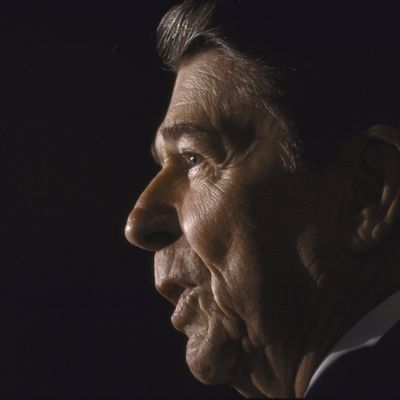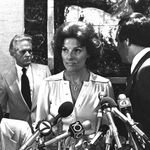
In 2020, at least one of the two major-party nominees is going to be the oldest in U.S. history, since Donald Trump, at 74, will be a record-setter (beating out Ronald Reagan ’84, Bob Dole ’96 and John McCain ’08). There’s a decent chance, however, that the 2020 contest will feature the two oldest nominees ever, if one of the two current Democratic front runners, Joe Biden (who will be 77 on Election Day) or Bernie Sanders (who will be 79) is nominated in Milwaukee next July.
Age hasn’t been a big issue in discussions of any of these esteemed gentlemen so far. Trump is so unusual in so many ways that his calendar age seems almost incidental. Sanders’s strong youth following has probably insulated him from some age-related inquiries. And it’s unclear whether voters really know how old any of these people are in the first place. But given the evidence that some voters are concerned about age, you have to figure some of Biden’s and Sanders’s Democratic rivals might find ways to hint at it (e.g., lots of talk about a “new generation” of leadership, or “fresh thinking,” etc.). An incident that suggests an age-related disability could raise eyebrows and fears, as it did for Dole and for Hillary Clinton.
The age of 2020 candidates may help create the impression that there is an upward trend in the age of presidents (or would-be presidents), which would make sense given steadily increasing life expectancies over the decades and centuries. And indeed, two of the three septuagenarian presidents, Reagan and Trump, were in office in the last 40 years. (Eisenhower, who at the end of his presidency was very briefly as old as Trump was when he began his, is the third.)
But actually, if you separate the 45 presidents into three chronological groups of 15, you get a surprise: The oldest is the first group of 15 presidents, from Washington through Buchanan (1789–1861), which averaged 57.1 years of age upon inauguration. The last 15, from Hoover through Trump (1929–present) averaged 56.3 years of age upon inauguration. (In case you were wondering, the middle group, from Lincoln through Coolidge, was by far the most youthful, averaging 51.6 years at inauguration, with nary a one taking office over 60).
What’s really changed is the relationship of presidential age to that of the relevant (for everyone other than Barack Obama) white male population. Statistics are spotty for the early years of the republic, and relatively high infant-mortality rates skew them, but average age expectancy at the turn of the 19th century was around 40. It was under 45 when William Henry Harrison took office at the age of 68 in 1840. It didn’t hit 50 until the early years of the 20th century. It passed 60 in the 1930s, and 70 around 1980. So most recent presidents were not as old compared to the voters who chose them. Today Bernie Sanders’s age is right at the life expectancy of white men. Compared to those early presidents, he and Biden really don’t stand out.
But just because Americans are living longer doesn’t necessarily mean they are immune from physical and cognitive decline, and that’s the real reason there might be some practical ceiling on presidential age, as I discussed in an earlier piece on the subject of presidential candidates who would turn 80 during their first term:
There are certainly octogenarians who are physically fit, sharp as a tack, and as competent at work as any whippersnapper. But it’s no secret that when people, particularly men, get to that age, the risk of mortality rises significantly (a 75-year-old man has a 22 percent chance of dying within six years), and along with it the possibility of cognitive deterioration (an estimated 15 percent of people between the ages of 80 and 84 suffer from some form of dementia). If voters fear any of that happening, it could (particularly with some encouragement from the kind of intensely hostile conservative media that Sanders and Biden were spared in 2016) affect their electability in ways that are not easy to anticipate in scope and power. And even more obviously, if a 77- or 79-year-old candidate suffers from any real or perceived impairment, the issue could take over the campaign to an extent that makes Hillary Clinton’s email problem look minor.
So from a historical perspective, Trump, Sanders, and Biden (and Elizabeth Warren, who will become a septuagenarian later this month) aren’t too old at all as compared to the rest of the population. From a health point of view, it’s hard to say if they are riskier propositions than younger pols. There is the cautionary tale of Reagan, whom many observers thought was showing signs of serious cognitive impairment during his second term. On the other hand, another president who was clearly impaired, Woodrow Wilson, was only 62 when he suffered a debilitating stroke, and three presidents (excluding those who were assassinated) never made it out of their 50s (and a fourth, the physically vigorous Teddy Roosevelt, barely did). So it’s always going to be a matter of individual capacities and health conditions.
If older-than-ever presidents really do become the wave of the future, it does suggest that the current trend of taking vice-presidential nominations seriously — and not simply awarding them to achieve ideological or geographic balance — is a good idea. “Accidental” presidents John Tyler and Andrew Johnson were calamities for their party and (arguably) their country, and Chet Arthur might have been had he not liberated himself from the political bosses who had owned him. The decision of Democratic leaders to substitute Harry Truman for Henry Wallace as veep in 1944 based on their justified fears about FDR’s health had enormous consequences. If the Donkey Party does nominate a 2020 presidential candidate who would require a raging fire of birthday candles, the second spot on the ticket should be occupied by someone who is more than a ticket-balancer. And if one of them wins and thrives, we can begin thinking about a “ceiling” for candidates that’s even higher.






























